Wind energy pricing remains attractive to utility and commercial purchasers, according to an annual report released by the U.S. Department of Energy and prepared by the Electricity Markets & Policy Group at the Lawrence Berkeley National Laboratory (LBNL). Prices offered by newly built wind projects are averaging around $0.02/kWh, driven lower by technology advancements and cost reductions.
According to the LBNL’s 2015 Wind Technologies Market Report, lower installed project costs – along with improvements in capacity factors – are enabling aggressive wind power pricing. After topping out at nearly $0.07/kWh in 2009, the average levelized long-term price from wind power sales agreements has dropped to around $0.02/kWh. Notably, the report cautions, this nationwide average is dominated by projects that largely hail from the lowest-priced central region of the country.
“Wind energy prices – particularly in the central U.S. – are at rock-bottom levels, with utilities and corporate buyers selecting wind as the low-cost option,” says Ryan Wiser, the LBNL’s senior scientist. “Moreover, enabled by technology advancements, wind projects are economically viable in a growing number of locations throughout the U.S.”
Other key findings from the report include the following:
- Wind power represented the largest source of U.S. electric-generating capacity additions in 2015. Wind power capacity additions in the U.S. surged in 2015, with $14.5 billion invested in 8.6 GW of new capacity. Wind power constituted 41% of all U.S. generation capacity additions in 2015 – up sharply from its 24% market share the year before and close to its all-time high. Wind power currently meets about 5% of the nation’s electricity demand and represents more than 10% of total electricity generation in 12 states and more than 20% in three of those states.
- Bigger turbines are enhancing wind project performance. Since 1998-1999, the average capacity of wind turbines installed in the U.S. has increased by 180% (to 2.0 MW in 2015), the average turbine hub height has increased by 47% (to 82 meters), and the average rotor diameter has increased by 113% (to 102 meters). Moreover, turbines originally designed for lower wind speeds are now regularly deployed in higher wind speed sites, boosting project performance. Increased rotor diameters, in particular, have begun to dramatically increase wind project capacity factors. For example, the average 2015 capacity factor among projects built in 2014 reached 41% compared with an average of 31% among projects built from 2004-2011 and 26% among projects built from 1998-2003.
- The report also finds that low wind turbine pricing continues to push down installed project costs. Wind turbine prices have fallen 20% to 40% from their temporary highs in 2008, and these declines are pushing project-level costs down. Wind projects built in 2015 had an average installed cost of $1,690/kW, down $640/kW from the temporary peak in 2009 and 2010.




